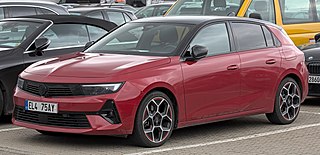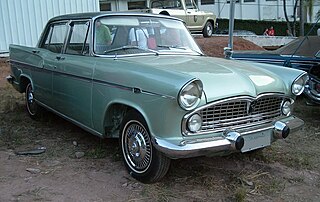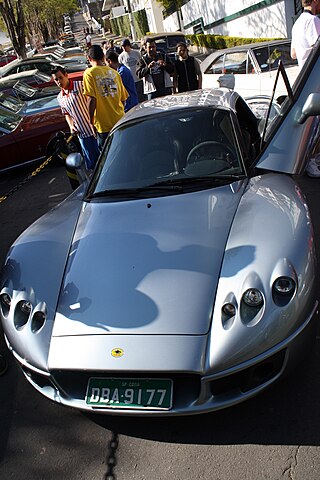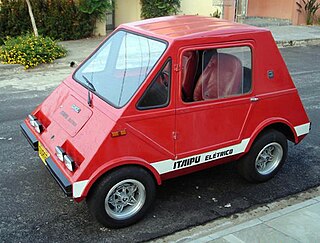
The Volkswagen Polo is a supermini car (B-segment) produced by the German car manufacturer Volkswagen since 1975. It is sold in Europe and other markets worldwide in hatchback, saloon, and estate variants throughout its production run.

The Opel Astra is a compact car/small family car (C-segment) developed and produced by the German automaker Opel since 1991, currently at its sixth generation. It was first launched in September 1991 as a direct replacement to the Opel Kadett. As of 2022, the car slots between the smaller Corsa supermini and the larger Insignia large family car.

The Jaguar E-Type, or the Jaguar XK-E for the North American market, is a British sports car that was manufactured by Jaguar Cars Ltd between 1961 and 1974. Its combination of aesthetics, high performance, and competitive pricing established the model as an icon of the motoring world. The E-Type's claimed 150 miles per hour (240 km/h) top speed, sub-7-second 0 to 60 mph (97 km/h) acceleration, unitary construction, disc brakes, rack-and-pinion steering, and independent front and rear suspension distinguished the car and spurred industry-wide changes.

The SEAT León, also spelled Leon in some other languages, is a hatchback compact car built by the Spanish car manufacturer SEAT since October 1999.

The Mitsubishi Lancer Evolution, popularly referred to as the 'Evo', is a sports sedan and rally car based on the Lancer that was manufactured by Japanese manufacturer Mitsubishi Motors from 1992 until 2016. There have been ten official versions to date, and the designation of each model is most commonly a Roman numeral. All generations use two-litre intercooled turbo inline four-cylinder engines and all-wheel drive systems.

The Ferrari 612 Scaglietti is an executive 2+2 coupé grand tourer manufactured by Italian automobile manufacturer Ferrari between 2004 and 2010. It was designed to replace the smaller 456; its larger size makes it a true 4 seater with adequate space in the rear seats for adults.
Noble Automotive Ltd, more commonly known simply as Noble, is a British sports car manufacturer based in Leicester. Noble Automotive Ltd. was established in 1999 by Lee Noble in Leeds, West Yorkshire, for producing high-speed sports cars with a rear mid-engine, rear-wheel drive layout. Lee Noble was the chief designer and part owner of Noble. The company was sold in August 2006. He left the company in February 2008 and shortly after announced his new venture, Fenix Automotive in 2009.

The Renault Scénic is a car which was produced by French car manufacturer Renault, the first to be labelled as a small multi-purpose vehicle (MPV) in Europe. The first generation was based on the chassis of the Mégane, a small family car. It became the 1997 European Car of the Year on its launch in November 1996. In May 2022 Renault announced it was discontinuing the standard Scénic with the Grand Scénic following shortly after. It will be relaunched in 2024 as a fully electric vehicle.

The Porsche 987 is the internal designation for the second generation Porsche Boxster sports car. It made its debut at the 2004 Paris Motor Show alongside the 911 (997) and went on sale in 2005.
The Santa Matilde, or SM4.1, is a sports car designed and produced in Brazil by Companhia Industrial Santa Matilde between 1977 and 1997.

The Fiat 147 was a three-door hatchback subcompact car produced by Fiat in the Brazilian state of Minas Gerais from autumn 1976 until 1987, when it was replaced by the Fiat Uno. It was the Brazilian variant of the Fiat 127. Some were also built by Sevel in Argentina until 1996, and assembly also took place in Colombia, Uruguay, and Venezuela.

The Renault Mégane Renault Sport is a series of high-performance hatchback models based on the Renault Mégane, produced since 2004 by the high-performance subsidiary company Renault Sport for its parent company Alpine, a subsidiary of Renault. The Mégane RS won awards such as "Best hot hatch" from What car? (2010–2014), "Highest placed non-supercar" in Evo's annual Car of the Year test 2011 and "Best hot hatch" from Top Gear.

The Simca Chambord is a car built by Simca do Brasil, a subsidiary of the French automobile manufacturer Simca. Based on the Simca Vedette, the first Brazilian Chambord left the production line in March 1959. It featured a standard 84 hp (63 kW) V8 engine, a 3-speed gearbox with the shifter located on the steering column, and was assembled from parts imported from France. Related models included the Simca Présidence, Simca Rallye, Simca Jangada, Simca Alvorada, and Simca Profissional.

The Simca Esplanada is a large car manufactured by Simca do Brasil in Brazil from 1966 to 1969. It was manufactured at Simca do Brasil's São Bernardo do Campo factory. Launched at the 1966 Salão do Automóvel in São Paulo, it replaced the Simca Chambord and related models. The basic platform of the Esplanada can be traced back through the French-built Simca Vedette to the Ford Vedette. The Emi-Sul engine was derived from the Ford Motor Company flathead V8 of 1932, thanks to the use of Zora Arkus-Duntov's "Ardun" hemispherical cylinder heads. This iteration was the last version of that design to be built for a production car.

The Lobini H1 is a sports car produced by the Brazilian automaker Lobini. It first appeared in 2005 and went through a minor redesign in 2007. It has a carbon steel tubular chassis and a fiberglass body shell. It makes use of a Volkswagen 1.8L turbocharged 20V engine, the same used in some versions of both Volkswagen Golf and Audi A3.

The eighth-generation Honda Civic is a range of compact cars (C-segment) manufactured by Honda between 2005 and 2012, replacing the seventh-generation Civic. Four body styles were introduced throughout its production run, which are sedan, coupe, and both three-door and five-door hatchback. The sedan version was introduced with two distinct styling for different markets, with one of them sold as the Acura CSX in Canada and as the Ciimo 1.8 in China from 2012 until 2016. The hatchback versions formed the European-market Civic range, which received a different architecture, body design and smaller footprint, and solely produced in Swindon, United Kingdom.

The Gurgel Itaipu E150 is an electric car, produced by the Brazilian automobile manufacturer Gurgel. The Itaipu was presented at the Salão do Automóvel in 1974, with an intended production start in December 1975. Only a few of these cars were produced and is today a collector's item. Top speed was of the first prototypes were of approximately 30 km/h (19 mph) and the latest models reached up to 60 km/h (37 mph). While about twenty pre-series cars were built, it was never commercialized. It was the first electric car built in Latin America, and, its specifications were comparable to similar models of the time. The car was named after the hydro-electric dam and power plant on the border of Brazil and Paraguay.

The Brazilian automotive industry is coordinated by the Associação Nacional dos Fabricantes de Veículos Automotores (Anfavea), created in 1956, which includes automakers with factories in Brazil. Anfavea is part of the Organisation Internationale des Constructeurs d'Automobiles (OICA), based in Paris. In 2021, the annual production exceeded 2.2 million vehicles, the 8th largest in the world.

The São Paulo International Motor Show is the biggest and most important automotive event in Latin America. The São Paulo International Motor Show has been held in São Paulo, Brazil since 1960. Originally being held irregularly, it has been a biannual show since 1984. In 1990 the event became internationalized and the domestic industry showed its capacity for global competition.

The Ford Fiesta Mk5 is the fifth generation of the Ford Fiesta supermini built in Europe between April 2002 and 2008. The Fiesta continued to be built in Mexico until 2010 and in Brazil until 2014. Most engines were carried over from the previous Fiesta. This generation became the best-selling Ford Fiesta generation to date. This was the first Fiesta to be sold in Asia and Australasia, where it replaced the Kia-based Festiva.


















